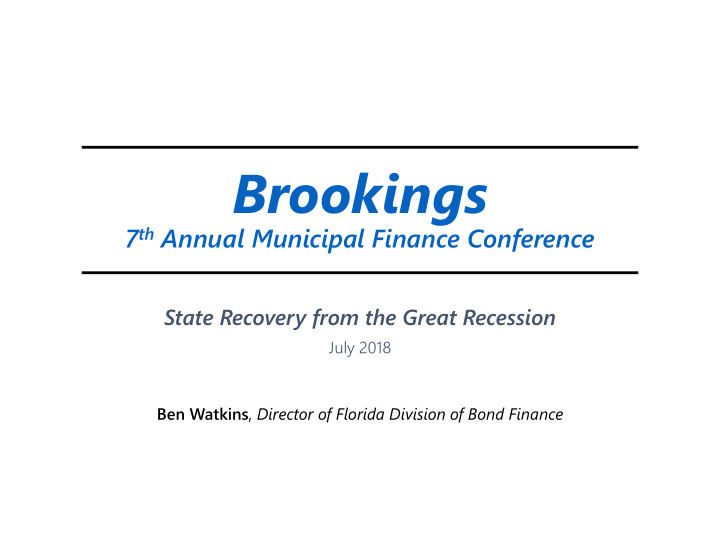



Brookings 7 th Annual Municipal Finance Conference State Recovery from the Great Recession July 2018 Ben Watkins , Director of Florida Division of Bond Finance
Florida’s General Revenue Decline $35 $32.2 $31.0 $29.6 $30 $26.2 $27.7 $28.3 $27.1 $26.4 $25.3 $25.0 $24.1 $25 $23.6 $21.8 $21.0 $21.5 $22.6 $15.7 $16.9 $17.9 $18.8 $19.2 $19.3 $20.0 ($ billions) $20 $15 $10 $5 $0 1997 1998 1999 2000 2001 2002 2003 2004 2005 2006 2007 2008 2009 2010 2011 2012 2013 2014 2015 2016 2017 2018 2019 Estimates Florida’s General Revenues declined by over $6 billion or 22% from FY 2006-2009 Declining revenues created budget gaps from FY 2008-2012 - Budget deficit reached as high as $5.5 billion in FY 2009 Page 1
Florida’s Profile Republican Control for many years - Executive branch and House and Senate Balanced Budget requirement - General and oblique (constitutional) - Appropriations cannot exceed revenues Revenue limit - Last year’s revenues plus growth in personal income Statutory framework for fiscal management - Revenue Estimating Conferences - Projected variances require action if >1.5% of forecast Policy Limit for Debt - Soft limit - Debt Service can’t exceed 6% of revenues Page 2
Budget Balancing Exercise The primary tools used by the State to address the revenue decline and resulting budget deficits included: - Spending Cuts Appropriations decreased nearly $6 billion from FY 2007 to FY 2010 Growth returned as recovery took hold -- FY 2019 total appropriations of $89.3 billion are $21.4 billion more than FY 2010 - Use of Reserves State spent over $7 billion of its reserves from FY 2006 to FY 2009 As revenues improved, State rebuilt reserves -- FY 2018 total reserves of $5.1 billion vs. $2.8 billion in FY 2009 - American Recovery and Reinvestment Act (“ARRA”) $5.5 billion in additional Federal funding from FY 2009 through FY 2011 which helped supplement General Revenue and Trust Funds - Raising Taxes Generated over $1 billion in additional recurring State revenues Page 3
Additional Steps Taken The State also implemented Pension Reform & Pension Holiday - State implemented Pension Reform in 2011 - Required employees to contribute 3% of salary, prospectively eliminated the Cost of Living Adjustment benefit, and extended vesting period - State’s pension funding holiday from FY 2011-2013 created $2.1 billion in additional budget flexibility Substituted financing for PAYGO in certain instances - Prisons 2009 financing ($450 million budget relief) Capital spending reductions, staff cuts, salary freeze State took action on specific bonding programs as needed - Documentary Stamp Taxes, which back State environmental bonds, decreased nearly 75% during the great recession ($4 billion in FY 2006 to $1 billion in FY 2010) - State responded by expanding the pledged revenues from 63% of Documentary Stamp Taxes to 100% Page 4
Anecdotal Observations of Other States Political acrimony – intraparty squabbles Late Budgets – Illinois is poster child Pension Holidays – chronic vs. episodic Ballot Initiatives/Revenue Limits Credit Downgrades Deficit Spending Connecticut - Recently embedded spending and borrowing limits in its General Obligation debt Page 5
What Matters Management - Demonstrated fiscal prudence Integrity of Institutional Processes - 3-year Plan - Revenue estimates Financial Discipline - Structural Budget balance - Timely Budget adoption - Avoiding one-shots or budget gimmicks Page 6
Recommend
More recommend